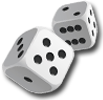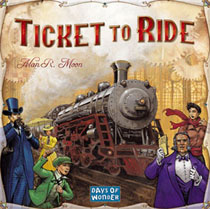



play board games
Board game reviews, strategy tips & session reports
Ticket to Ride Game Review
 Stats
Stats
No. of players: 2-5
Amount of time to play: 30 – 90 minutes
Age requirements: 8+
Set-up time: 5 min
Description:
Ticket to Ride is a board game that is easy to learn and fun to play. Your goal is to score the most points by laying trains to connect cities in the United States. The person with the most points when someone runs out of trains wins the game.
You set up the board by placing the shuffled deck of Train Cards next to the board and flipping the top five cards face-up next to the pile. You also shuffle the Destination Cards. To start each player receives 3 Destination Tickets and a hand of 4 Train cards. The first thing you should do is look through your Destination Cards to see which routes you’ll try to complete. Across the top of the Destination Card you’ll see the cities you must connect. The number of points you’ll score if you complete the route is in the lower right-hand corner of the card. The longer the route the more points it is worth. You must keep 2 of your initial 3 Destination cards, but may keep all 3 if you wish. Discarded Destination cards go to the bottom of the pile. In order to connect the two cities on your Destination Card you must have continuous line of trains between them.
On your turn you may do one of three things: place trains, take train cards or draw more destination cards.
You lay trains by collecting a set of cards that match the number and color of the spaces on the board. If the spaces are gray then any set of colors that match the number of spaces between the cities will work. You may not partially connect two cities. The more trains you place, the more points you score.
You collect cards by taking one from the 5 displayed by the board and then flipping the top card of the draw deck to fill its spot or you may choose to just take a card blindly from the top of the draw deck. You can draw two cards in this way on your turn unless you draw a face up wild. A face up wild counts as 2 drawn cards and cannot be taken as your second draw.
You may also choose to draw more destination cards. This can be a risky proposition. You draw three cards and have to keep one of them. You might find a route that you have already connected…Great free points. On the other hand you may have to keep a route you don’t have enough trains to complete.
When one players stock of trains is 2 or less, everyone (including that player) gets one last turn. After that you calculate your final score. Any routes you connected score you the points written on the destination card. Any routes you failed to complete score you minus the points printed on the destination card. Lastly the player with the longest train scores an extra 10 points. Ties for the longest train result in both players scoring 10 points.
A Quick Review:
Ticket to Ride is very easy to learn and many call it a gateway game for more complicated hobby gaming. This game is a light strategy game that is a lot of fun. I say that because most of the people I play with are not too cut throat. We rarely try to block someone from their obvious route and will only sometime s interfere with someone going for the longest train. I think those things might make Ticket to Ride a more strategic intense game. That being said I like playing nice and still have fun every time I play.
The only drawback to this game is that keeping score while you play can be difficult and we always check everyone’s score before we declare a winner. This is a bit time consuming but not too big a deal.
Score and synopsis: (Click here for an explanation of these review categories.)
Strategy 3 out of 6
Luck 4 out of 6
Player Interaction 3 (4 if you play more cut throat) out of 6
Replay Value 5 out of 6
Complexity 2 out of 6
Fun 4 out of 6
Overall 4 out of 6

we play ticket to ride: europe and we only score at the end of the game, it’s easier to avoid mistakes